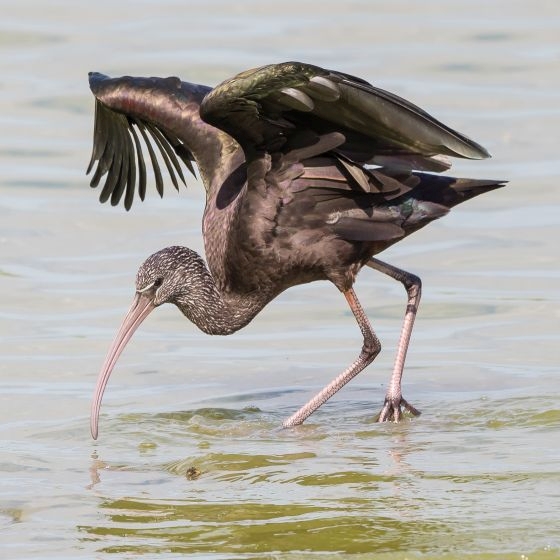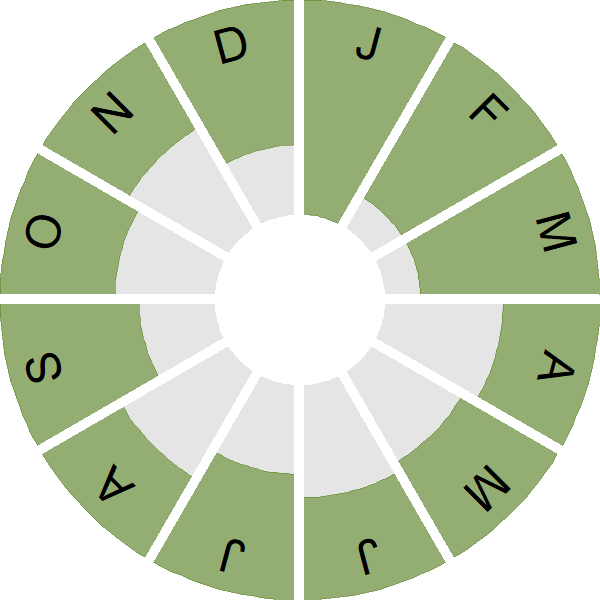Glossy Ibis

Introduction
This rather smart bird, with its glossy green and purple-brown plumage, is not much bigger than a Curlew, something that surprises many encountering the species for the first time.
The Glossy Ibis has become more familiar to birdwatchers following a series of mass arrivals in the 2000s. Increasing numbers of reports since then mirror an increase in the breeding population located in the south-west of Europe. There have been a number of breeding attempts here, and it is likely that more regular breeding will be a feature in the future.
Climate change is thought to have supported the growth in visiting Glossy Ibis to Britain, with milder winters aiding their survival and enabling individuals to attempt breeding attempts the following year.

Key Stats
Identification
Songs and Calls
Flight call:
Status and Trends
Conservation Status
Population Change
Glossy Ibis used to be considered a scarce migrant in the UK; however, numbers have increased considerably from one or two individuals seen in the 1990s to over 220, from 50 recording areas, in 2022 [White & Kehoe 2024]. Glossy Ibis bred successfully in the UK (in Cambridgeshire) for the first time in 2022; two other pairs were observed nest building in Cornwall and Cleveland and the species is now classified as a colonising breeder [Eaton & the Rare Breeding Birds Panel 2024].
Distribution
These maps show the distribution at the start of an invasion, a phenomenon that has continued, with individuals and small flocks of Glossy Ibises seemingly resident at several locations in southern Britain. Breeding seems likely in the coming years.
Occupied 10-km squares in UK
2007/08–10/11
or view it on Bird Atlas Mapstore.
2008–11
or view it on Bird Atlas Mapstore.
European Distribution Map
Distribution Change
Change in occupied 10-km squares in the UK
from 1981–84 to 2007–11
or view it on Bird Atlas Mapstore.
Seasonality
Glossy Ibis was formerly a rare vagrant, but is now a scarce resident and potential breeder at many southern locations.
Weekly pattern of occurrence
The graph shows when the species is present in the UK, with taller bars indicating a higher likelihood of encountering the species in appropriate regions and habitats.

Movement
Britain & Ireland movement
Foreign locations of birds ringed or recovered in Britain & Ireland
Dots show the foreign destinations of birds ringed in Britain & Ireland, and the origins of birds ringed overseas that were subsequently recaptured, resighted or found dead in Britain & Ireland. Dot colours indicate the time of year that the species was present at the location.
- Winter (Nov-Feb)
- Spring (Mar-Apr)
- Summer (May-Jul)
- Autumn (Aug-Oct)

European movements
EuroBirdPortal uses birdwatcher's records, such as those logged in BirdTrack to map the flows of birds as they arrive and depart Europe. See maps for this species here.
The Eurasian-African Migration Atlas shows movements of individual birds ringed or recovered in Europe. See maps for this species here.
Biology
Survival and Longevity
Survival is shown as the proportion of birds surviving from one year to the next and is derived from bird ringing data. It can also be used to estimate how long birds typically live.
View number ringed each year in the Online Ringing Report.
Classification, names and codes
Classification and Codes
- Order: Pelecaniformes
- Family: Threskiornithidae
- Scientific name: Plegadis falcinellus
- Authority: Linnaeus, 1766
- BTO 2-letter code: IB
- BTO 5-letter code: GLOIB
- Euring code number: 1360
Alternate species names
- Catalan: capó reial
- Czech: ibis hnedý
- Danish: Sort Ibis
- Dutch: Zwarte Ibis
- Estonian: tõmmuiibis e. läikiibis
- Finnish: pronssi-iibis
- French: Ibis falcinelle
- German: Sichler
- Hungarian: batla
- Icelandic: Bognefur
- Irish: Íbis Niamhrach
- Italian: Mignattaio
- Latvian: brunais ibiss
- Lithuanian: rudasis ibis
- Norwegian: Bronseibis
- Polish: ibis kasztanowaty
- Portuguese: íbis-preto
- Slovak: ibisovec hnedý
- Slovenian: plevica
- Spanish: Morito común
- Swedish: bronsibis
- Welsh: Ibis Du
More Evidence
More evidence from Conservation Evidence.com
Partners
Citing BirdFacts
If you wish to cite particular content in this page (e.g. a specific value) it is best to use the original sources as linked in the page. For a more general citation of the whole page please use: BTO (20XX) BirdFacts Species: profiles of birds occurring in the United Kingdom. BTO, Thetford (www.bto.org/birdfacts, accessed on xx/xx/xxxx).

